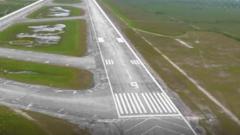The concept of placing data centres on the Moon is gaining traction, as companies strive to meet the escalating need for data processing and storage solutions. Lonestar's recent success with a test model on the Moon highlights the potential of space-based facilities offering limitless solar energy and security benefits. However, technical and financial challenges remain significant hurdles to making this vision a reality.
A New Frontier: The Race to Establish Data Centres on the Moon and Beyond

A New Frontier: The Race to Establish Data Centres on the Moon and Beyond
As demand for data storage surges, innovative companies like Lonestar are exploring the potential of lunar data centres, promising enhanced security and renewable energy.
In a move that sounds reminiscent of science fiction, Lonestar Data Holdings is set to revolutionize data storage by establishing data centres in lunar terrain. Stephen Eisele, President of Lonestar, believes that placing data centres on the Moon could provide unprecedented security. Following a successful test of a miniature data centre—comparable to a hardback book—that journeyed to the Moon aboard Intuitive Machines' Athena Lunar Lander, the company's ambitious plans are solidifying. The launching vehicle for this mission was none other than Elon Musk’s SpaceX.
Data centres, essential infrastructures for housing and processing vast quantities of information for various sectors, increasingly face challenges on Earth. Demand for these facilities is escalating due to the burgeoning reliance on artificial intelligence, with industry analysts projecting an annual growth of up to 22% in the coming years. As the need for data storage intensifies, finding suitable locations on Earth has become increasingly difficult, with local opposition to new facilities citing environmental concerns and high energy consumption.
The envisioned solution of placing data centres in orbit or on the Moon addresses both site scarcity and environmental issues, as these celestial operations can harness abundant solar power without local populations to contest their presence. Recent studies, including the Ascend report by Thales Alenia Space, have explored the feasibility of data centres in orbit around Earth, suggesting they could significantly transform the digital landscape within Europe while potentially being more environmentally sustainable.
Thales Alenia Space proposes a network of satellites with substantial data processing capabilities, though experts acknowledge significant investments and breakthroughs in rocket technology will be necessary for this to occur by the mid-2030s. Yet, voices in the scientific community urge caution. Dr. Domenico Vicinanza from Anglia Ruskin University emphasizes the considerable challenges facing space-based data centres, particularly the high costs of launch, the complexities of necessary infrastructure, and the technical difficulties posed by zero-gravity environments.
Despite these challenges, the confidence of companies like Lonestar remains unwavering. They argue that the unique characteristics of space-based data infrastructure provide unparalleled security benefits, with the ability to bypass terrestrial networks. Lonestar plans to deploy another data centre in lunar orbit by 2027 and already has clientele lined up, including government entities.
With the idea of data centres in space morphing from a curious thought into a potential reality, firms like Lonestar and Washington's Starcloud are set to push forward rapidly. For many, this innovation in data storage could reshape the landscape of digital information in profoundly significant ways.




















